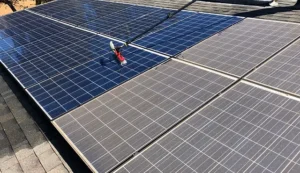The installation of solar energy systems by businesses is one step in the sustainability journey. However, the journey doesn’t end with the installation of solar panels. Effective maintenance and servicing is crucial to ensuring the longevity and maximum efficiency of your solar investment. Yet, this very aspect introduces a significant concern for many businesses: the cost and scheduling of solar maintenance.
Understanding Maintenance Costs
The Real Cost of Solar Maintenance
Solar panel maintenance is often perceived as a hidden cost that catches many businesses off guard. In reality, solar systems are relatively low maintenance compared to other energy systems. The primary expenses include annual system servicing, periodic cleaning of the panels and the occasional replacement of components such as inverters or batteries. As technical experts GSES have written in an article, sometimes it becomes a choice whether it is worth conducting maintenance based on the cost to fix the issue – sometimes you will wait until more problems to arise to maximise the ROI.

Factors Influencing Maintenance Costs
Several factors can influence these costs, including the size of the solar installation, the environment (e.g., areas with high dust levels may require more frequent cleaning), and the specifics of the maintenance contract.
In extreme cases, solar panels with dust can cause underperformance of 30-40% of system performance.
Understanding these factors can help businesses budget more effectively for ongoing costs.
Scheduling Maintenance for Minimal Disruption
Proactive vs. Reactive Maintenance and Servicing
Adopting a proactive maintenance schedule, rather than a reactive one, can significantly reduce both costs and system downtime. Scheduled maintenance and servicing allows businesses to plan ahead, minimizing the impact on daily operations. Conversely, reactive maintenance, which occurs in response to a problem, often leads to unplanned downtime and potentially higher costs.
Omni offers different Solar Audit and Servicing packages to suit both proactive and preventative servicing and maintenance to ensure your assets is performing optimally.
Seasonal Scheduling for Servicing

Scheduling maintenance during periods of lower solar generation, such as the winter months in some regions, can ensure
that systems are operating at peak efficiency when sunlight is most abundant. This strategic scheduling can enhance energy production and savings. Timing the maintenance before the peak efficiency is optimal as you want the solar system to be ‘ready’ for peak output in the Aussie summer months especially as the sun warms us all up.
Optimizing Maintenance Costs and Scheduling
- Regular Monitoring: Implementing a system to monitor solar panel performance through inverter monitoring portals/apps (Sungrow, Fronius, Enphase) or Solar Analytics can help identify issues early, before they require major repairs. If you don’t have time for this, Omni provides a service to keep on top of your system data.
- Maintenance Contracts: Consider maintenance contracts that offer a balance of cost-effectiveness and comprehensive service. These contracts can provide peace of mind and spread out maintenance costs over time.
- DIY Maintenance: Some aspects of maintenance, particularly cleaning, can be managed in-house with the proper training and safety measures. This approach can reduce costs but should be balanced with professional inspections.
- Leverage Technology: Technological solutions like drone inspections and automated cleaning systems can reduce the cost and frequency of manual maintenance.
The Bottom Line
The key to managing maintenance costs and scheduling is to approach solar system maintenance as an integral part of your solar energy investment. By understanding the factors that influence maintenance costs, adopting a proactive maintenance strategy, and leveraging technology and smart scheduling, businesses can ensure their solar systems operate efficiently and effectively for years to come.
Investing in solar energy is a significant step toward sustainability for any business. With the right approach to maintenance, this investment can continue to pay dividends in reduced energy costs and environmental impact, all while supporting your business’s operational goals.
